Drywood Termite
Drywood termites are a type of termite that live and feed on dry wood, as opposed to subterranean termites, which live and feed on damp wood. They typically infest the structural wood of buildings, such as the framing, flooring, and furniture. Drywood termites are usually found in warm coastal regions and are less common in colder climates. These termites do not require contact with the soil, and they can establish colonies in any piece of wood with a moisture content of less than 20%. They typically enter structures through small cracks or holes in the wood and can cause significant damage if left untreated.
Drywood Termites Behaviour
Drywood termites are a type of termite that infest dry wood and do not require contact with the soil. A single colony can spread over several meters and occupy multiple locations within a structure. They obtain all the moisture they need from the wood consumed or through their metabolism, meaning they do not require an above ground source. These termites consume spring and summer wood, leaving behind clean and smooth galleries. They often enter homes through unscreened vents, cracks in the building exterior or around window and door frames, soffits, fascia boards, and roof seating. To retain moisture, their cuticle is more water-resistant than that of subterranean termites.
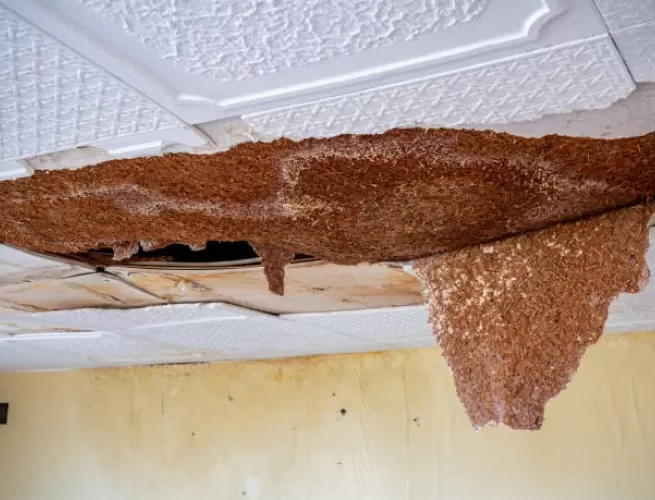
Why is Drywood Termites a pest?
Drywood termites are considered pests because they can cause significant damage to the structural wood of buildings, such as the framing, flooring, and furniture. They can establish colonies in any piece of wood with a moisture content of less than 20%, and they can consume spring and summer wood. A single colony can spread over several meters and occupy multiple locations within a structure, making detecting and eliminating the infestation hard. The damage caused by drywood termites can weaken the structural integrity of a building, making it unsafe to live in. They can also cause aesthetic damage to furniture and other wooden items.
In addition, they can be costly to exterminate, and the control measures can be disruptive to the homeowners. Drywood termites also can be a nuisance as they can swarm in large numbers, which can be alarming for homeowners. Thus, for these reasons, drywood termites are considered pests, and it is vital to take steps to prevent and control infestations.
igns of Drywood Termites infestations
Several signs may indicate a drywood termite infestation:
- Swarmers: During certain times of the year, adult drywood termites will swarm or fly out of the nest in search of new areas to colonize. These swarms can signify an infestation, primarily if the swarmers are found inside the home.
- Frass: Drywood termites excrete a small, sawdust-like material called frass. This material can accumulate below the infestation and indicates drywood termites are present.
- Damaged Wood: Drywood termites consume the wood from the inside out, leaving a thin layer of intact wood on the surface. This can cause the wood to sound hollow when tapped, resulting in minor or “kick-out” holes on the surface.
- Wings: After swarming, drywood termites will shed their wings, which can be found near windowsills, door frames, and other areas where they may have entered the home.
- Discolouration or Warping: As drywood termites consume the wood, it can become discoloured or start to warp. This is a sign that the infestation has been present for some time.
It’s important to note that one or more of these signs does not necessarily mean that drywood termites are present. It could be other pests or natural causes. Therefore, a professional pest control inspector should be consulted to confirm an infestation and identify termite species.
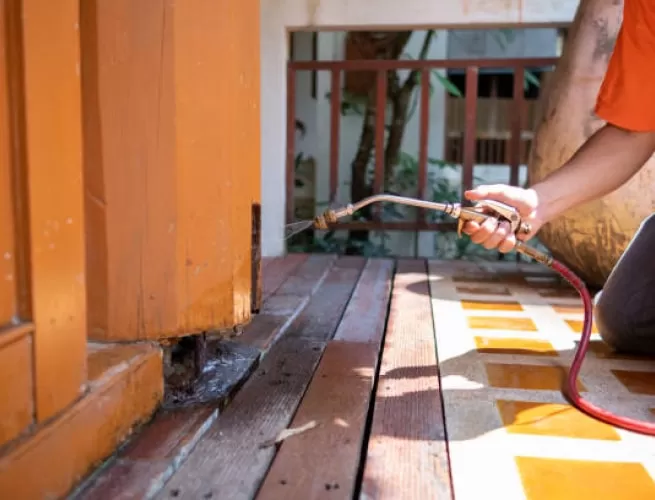
Suspect Drywood Termite infestation?
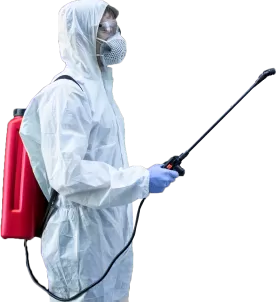
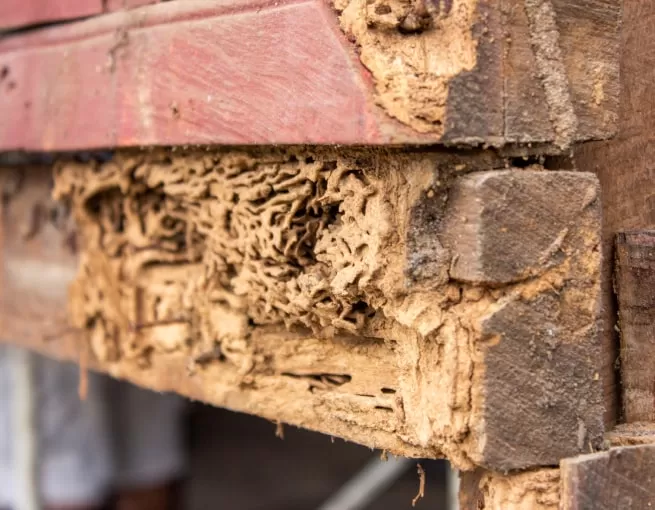
How to Prevent Drywood Termites Infestation
Several steps can be taken to prevent drywood termite infestations:
Drywood termites require less than 20% moisture content in the wood they infest. By eliminating sources of moisture in and around the home, such as leaks, condensation, and poor drainage, you can make your home less attractive to drywood termites.
Drywood termites can enter through even the smallest gaps in your home’s structure. Seal cracks in foundations, walls, and gaps around windows and doors to create a barrier that makes it harder for termites to access the wood within your property.
Wood stored close to your home can attract termites, giving them easy access to your structure. Keep firewood, lumber, and other wooden items at least 20 feet away from your house and off the ground to minimize the risk of infestation.
Poor ventilation in enclosed spaces like attics and crawl spaces can create damp conditions that attract termites. Make sure these areas are well-ventilated to reduce humidity, keeping the environment less appealing to termites.
A proactive approach to termite prevention includes regular inspections. Schedule inspections with a pest control professional to spot early signs of termite activity and address any potential issues before they become infestations.
Applying a chemical barrier around the perimeter of your home can be an effective termite deterrent. This treatment repels or kills termites attempting to enter the property, providing a protective buffer around your foundation and wooden structures.
Wood treatments, such as borate sprays, make wood less palatable to termites, reducing the risk of infestation. Treat exposed wood elements in your home to protect them from termites and extend their longevity.
It’s important to note that preventing drywood termite infestations can be complex, and a professional pest control expert can provide additional advice and guidance.
Under a franchise arrangement with TermiCam Australia in 2002, Aardwolf Pestkare is the first company in Asia to employ Thermal Imaging to detect Termite Infestation.
A piece of equipment will remain just a tool unless it is handled by qualified professionals. Aardwolf Pestkare is proud that all its Thermographers are trained in Australia and certified by the Australian Institute for Non-Destructive Testing (AINDT).
This explains why Aardwolf Pestkare’s Termite Management Programme enjoys an estimated 98% success in detecting Termite presence and entry points accurately and promptly, so that effective treatment can be carried out before further damage is caused.
This is what the highly sophisticated TermiCam sees:
As proof of our reliability, Aardwolf Pestkare is the first pest management company in Singapore to offer financial protection against timber damage caused by Subterranean Termites.
Drywood Termites Control Measures:
Here are some of the ways Aardwolf Pestkare can help you:
- Remedial treatment includes wood replacement, liquid treatment, spot treatment, heat treatment and fumigation.
- Preventive strategies include pressure-treatment with wood preservatives such as Alkaline Copper Quaternary (ACQ).
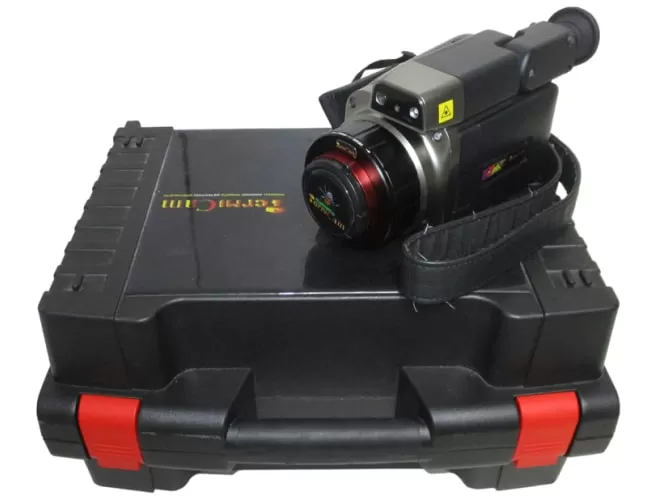
Frequently Asked Questions (FAQ) - Pest Control in Singapore
Drywood termites are about 1/4 to 1/2 inch long and are typically light brown to dark brown in color. They have six legs, two antennae, and a straight waist. Their wings are longer than their body, and they have a thick, hard exoskeleton.
Drywood termites are about 1/4 to 1/2 inch long and are typically light brown to dark brown in color. They have six legs, two antennae, and a straight waist. Their wings are longer than their body, and they have a thick, hard exoskeleton.
Drywood termites are about 1/4 to 1/2 inch long and are typically light brown to dark brown in color. They have six legs, two antennae, and a straight waist. Their wings are longer than their body, and they have a thick, hard exoskeleton.
Drywood termites are about 1/4 to 1/2 inch long and are typically light brown to dark brown in color. They have six legs, two antennae, and a straight waist. Their wings are longer than their body, and they have a thick, hard exoskeleton.
Drywood termites are about 1/4 to 1/2 inch long and are typically light brown to dark brown in color. They have six legs, two antennae, and a straight waist. Their wings are longer than their body, and they have a thick, hard exoskeleton.
Drywood termites are about 1/4 to 1/2 inch long and are typically light brown to dark brown in color. They have six legs, two antennae, and a straight waist. Their wings are longer than their body, and they have a thick, hard exoskeleton.
Drywood termites are about 1/4 to 1/2 inch long and are typically light brown to dark brown in color. They have six legs, two antennae, and a straight waist. Their wings are longer than their body, and they have a thick, hard exoskeleton.
